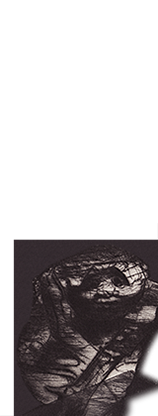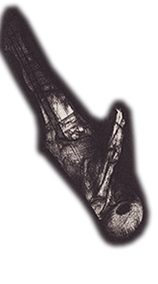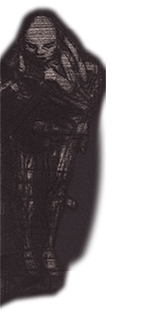Burning the Dead
The text Brûler les morts is taken from a short story with the same title by Amarante Szidon, the artist’s daughter. The photographs were taken by Jorge Amat in 1988, a few days after a major fire in the studio at Hérouval.
Click on the images to enlarge them
(large and extra large sizes)
❧
Fullscreen
slideshow
Johann Sebastian Bach, The Passion according to St. John – Christus, der uns selig macht
Ramin, Thomanerchor Leipzig,Gewandhausorcherster, 1956
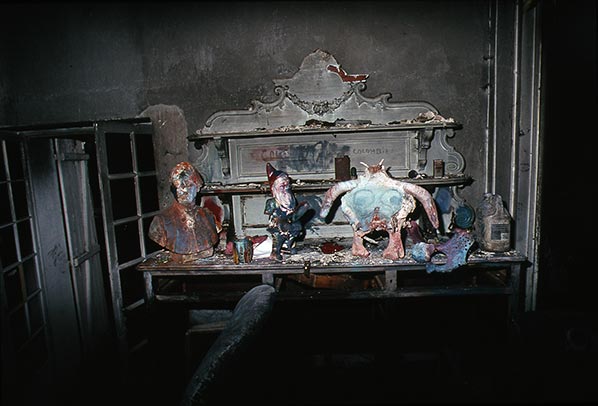

One summer, making the most of the fact that the armchairs had been pushed forward in the Cabinet of Natural History, my father arranged the studio as a kind of stage set; the chairs were placed in rings as if expecting visitors. In truth, nobody never dared to sit down on them; we circumnavigated them warily, as one picks one’s way through a battlefield littered with corpses, trying not to stumble over severed limbs. Over the coming weeks, it became obvious that the long-awaited guests were none other than the creatures in the paintings whose breath could almost be heard through the leather or the fibers of the covers. For the most part, it was eyes and a mouth that emerged on the visible side of the armchair; exactly where those which had possessed them had taken their places. My father delighted in staging uncertain resurrections with these easy-chairs, to give the dead a voice. The armchairs of the Cabinet of Natural History were his nameless guests, taken in and lodged in the chapel of his studio like refugees. Frozen phantoms, they had neither name nor definite gender, and I occasionally would hear them dialog in a low voice with other invisible presences, waiting not without fear for their incarnation by the master’s hand. Since time immemorial, these invisible presences have been circulating round the mill at H., sources of childish daytime terrors, which, at night, calmed down and fell silent. With the armchairs, some became embodied, after years, decades perhaps, of floating in the void – to my singular relief, it has to be said: it’s at last possible to confront them. In the studio, at the mill at H., I had something to cling on to.
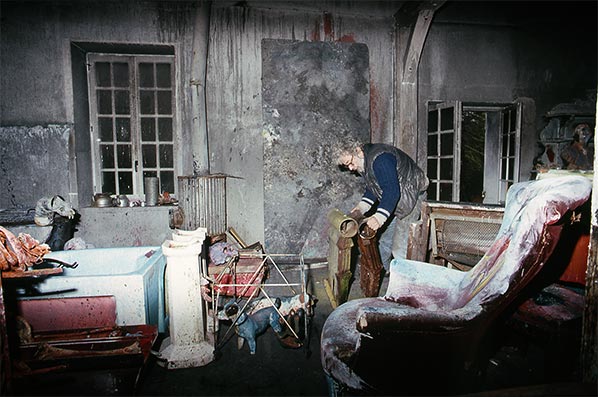
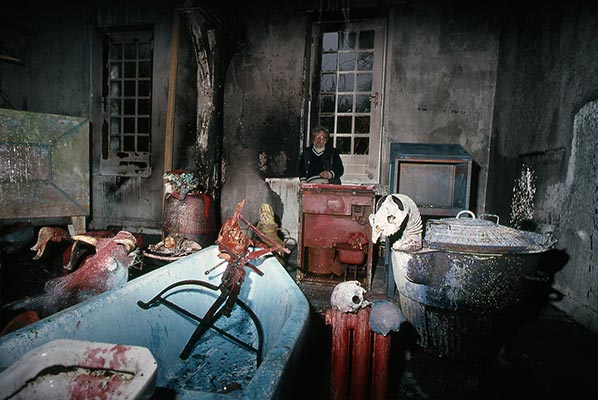

My father leaves first; instead of skirting round the pond as usual, he turns down the sloping path flanked by a stone wall that leads to the cellar. I paced behind him, my legs trembling a bit, I guess they are unsure on the concrete beneath my feet; it’s always been hostile to me – walking in a too much of a rush, managing not to trip by sheer luck, – and of the green moss growing on the wall – the principal source of my adolescent nightmares. On the path a couple of cats brush past me mewing in annoyance, in a hurry to continue their dalliance our arrival had interrupted. In front of the studio the lawn is carpeted with goose feathers mixed with ash and rubble from the fire; the feathers, like the fragments of down, look dirty and leaden. Now the ground is haunted; I’ve never seen it looking like this. I arrive bewitched before the door to the studio that my father had already repainted; the panes in the upper section reflect the grave autumn sunlight. The very last leaves on the pear tree, sparse on the branches, cast shadows that curl gently on the door, lifted by a light breath in the surrounding air.


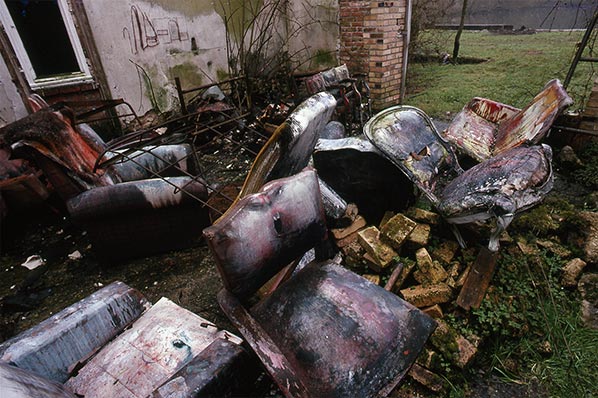
Once on the threshold, I hold back an instant, listening for the breathing. With trembling hands, I carefully raise the handle. My fingers are covered with traces of the fire spreading out in an infinite range of hues, transforming my hand into a burnt-out fan. Within, and for the foreseeable future, darkness has settled in. The ash and dust has coated the armchairs, the brushes, the tubes of painting abandoned on the board that served as a palette. It has even overrun the walls, where it sticks like a second skin. In spite of this strange damp and chilly atmosphere, the gloom is not at all disturbing; one soon feels quite at ease in its company, as it’s almost a relief in comparison to the metallic light outside, and it plunges you unconsciously into a kind of torpor. Very quickly, my body is engulfed by a muffled languor, while my eyes grow accustomed to the dark and I start differentiating the mobile forms from the immobile. Emerging from nowhere the moving figures are my father and my sister, by his side, like his shadow; the motionless, the other armchairs, a disused bathtub, the water-clogged stove, some empty buckets upside-down on the floor. As for the canvases, they must have been put elsewhere, because they’re not here anymore. Damaged, surely by fire and then by the salutary water from hoses brought in by uniformed colossuses.
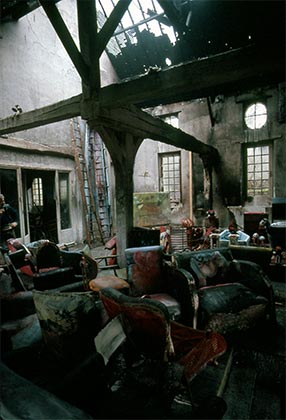
The undamaged armchair is placed at the end of the main wall, where canvases awaiting execution used to be stored. My father then disappears into an adjoining room. I’m still standing at the entrance to the studio; my sister beckons me over, wheeling her arms, and uttering words a noise in the background I can’t identify renders inaudible. I climb the little stairway; as I’m walking over the damp, slippery floor, I bang my foot against some empty pots of paint strewn over the floor, soaked and blackened. Once up to where my sister is, I lean against the front of the old stove facing the main wall. I’ve almost completely stopped retching now, and I’m ready for the coming together of hearts amid the ash.
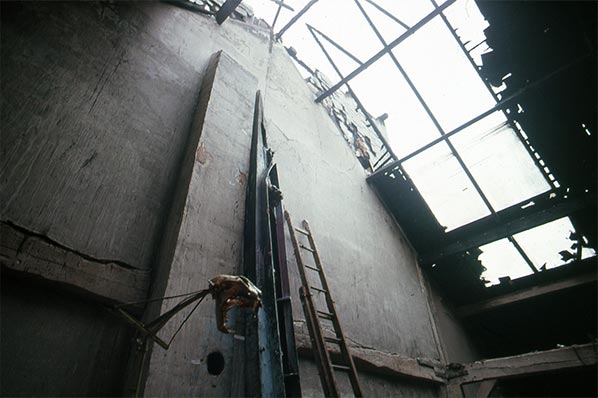
What I took for background noise is none other than the Passion according to St. John playing on a tape-recorder set up in the side room. It’s a Passion that I already know by heart, to the point of being able to recite the sung text in my daydreams: the final chorus from the first part has always seemed sublime to me owing to the silence that precedes it. My limbs turned to stone, holding my breath, I lie in wait for this brief moment of total silence whose ineluctable faith terrifies you, and for the chorus that interrupts it, as if wrenched from mortal speech. In the gutted studio, voices intoning Christus, der uns selig macht resound up to the clouds. Their ascending curves match the rusty rungs of the ladders leaning against the blackened wall; of unequal height, the three ladders lead directly up to a sky of a deep blue. I hadn’t noticed them when I came in, perhaps because they merge into the wall burnt to cinders, and that only the ends are visible. It was my father’s idea to store them there, just in case. I think they’ll never be of any use at H.; and, anyhow, they’re not even intended to be used. The rusted ladders in the studio encapsulate a world I can only glimpse between the top rungs. The chorus fades; the cassette stops with its characteristic click; henceforth it’s human voices that take over, with and without the fire.
Amarante Szidon
Translated from French by D. Radzinowicz
